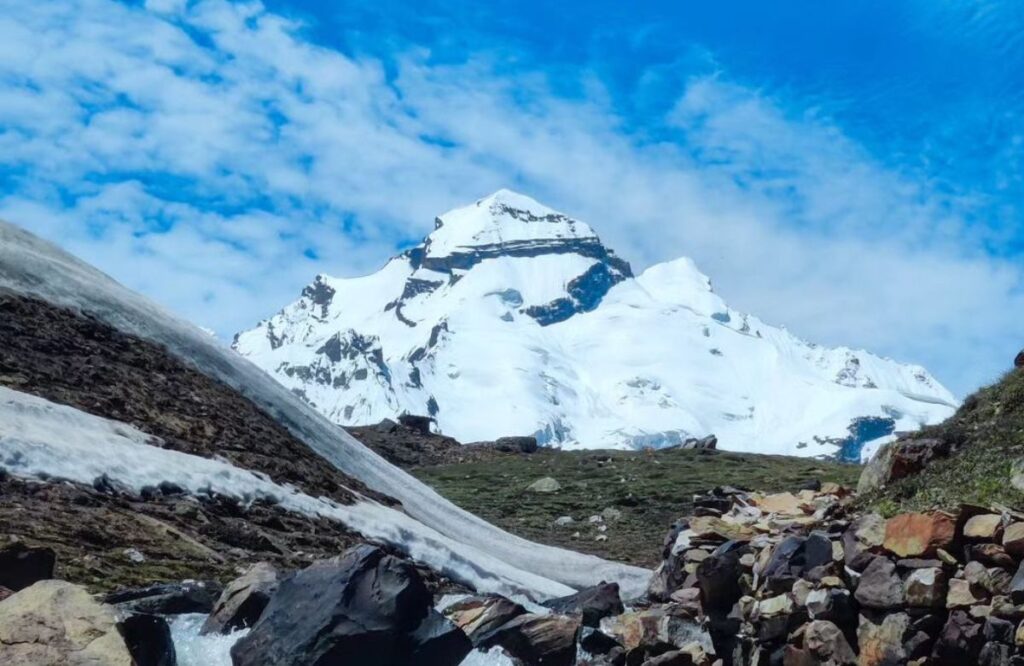Nestled in the tranquil embrace of the Himalayan range, Om Parvat stands as a majestic peak, shrouded in mystique and revered for its religious significance. As nature enthusiasts and pilgrims alike embark on journeys to witness the awe-inspiring beauty of this sacred mountain, understanding the weather and temperature details becomes crucial for a safe and enjoyable experience.
Om Parvat, a timeless spectacle, stands as a testament to the grandeur of nature and the spiritual allure embedded in the Himalayan landscape.
As pilgrims tread the paths leading to this sacred summit, the mastery of weather nuances becomes paramount for a seamless expedition.
The tranquility surrounding Om Parvat belies the potential challenges posed by the ever-changing mountain weather.
Pilgrims and nature enthusiasts alike must navigate the varying temperatures and atmospheric conditions that characterize the journey to this hallowed peak.
Geographical Context of Om ‘ॐ’ Parvat
Om Parvat is situated in the Pithoragarh district of Uttarakhand, India, and is known for the enigmatic “OM” “ॐ” symbol naturally formed on its snow-covered slopes. The region is characterized by its challenging terrains and high altitudes, making it imperative for visitors to be well-informed about the weather conditions.
Temperature Fluctuations in Om ‘ॐ’ Parvat
The climate enveloping Om Parvat is characterized by its high-altitude setting, delivering frigid temperatures and capricious weather patterns. Positioned at an elevation of approximately 6,191 meters (20,310 feet), the mountain demands respect, challenging the resilience of both spiritual seekers and nature aficionados. Embracing a subarctic climate, Om Parvat experiences temperatures that often dip well below freezing, particularly during the winter months.
In the summer season, stretching from May to September, the weather becomes relatively milder, offering a more favorable environment for pilgrimage and exploration. Daytime temperatures typically range between 10 to 15 degrees Celsius (50 to 59 degrees Fahrenheit), providing a reprieve from the winter’s biting cold. Nevertheless, even during the summer, nighttime temperatures can plummet, necessitating adequate clothing and preparation.
The monsoon season, spanning from July to September, introduces the challenge of heavy rainfall, rendering trekking trails slippery and potentially perilous. Pilgrims must exercise caution and strategic planning to navigate these monsoon-related obstacles effectively.
Winter, from October to April, unveils its extreme cold, with temperatures frequently dropping to -15 degrees Celsius (5 degrees Fahrenheit) or even lower. The landscape transforms into a pristine expanse as snow blankets the surroundings, intensifying the mystical ambiance. This season poses the greatest challenge for pilgrims, demanding specialized gear and a profound understanding of the unforgiving conditions.
Preparing for the Journey
Given the diverse weather patterns, visitors to Om Parvat must be well-prepared. Essential items include warm clothing, sturdy trekking gear, waterproof layers, and proper footwear. It is advisable to check weather forecasts before planning the trip and to be aware of any travel restrictions or advisories issued by local authorities.
Conclusion and Final words
Om Parvat, with its spiritual significance and breath taking landscapes, beckons explorers to uncover its secrets. Understanding the weather and temperature details is crucial for ensuring a safe and enjoyable journey. As the seasons change, so does the character of this sacred mountain, offering a unique and awe-inspiring experience to those who dare to venture into its divine embrace.


